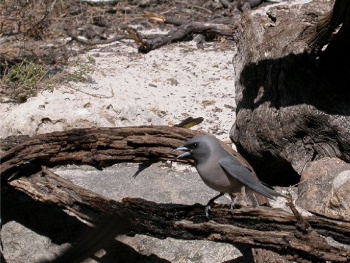(→External Links: Multiple GSearches combined) |
|||
| (7 intermediate revisions by 6 users not shown) | |||
| Line 1: | Line 1: | ||
| − | + | [[Image:Masked_Woodswallow.jpg|thumb|550px|right|Male<br />Photo © by {{user|Pearly_Shells|Pearly_Shells}}<br/>Gluepot Reserve, [[South Australia]], October 2004]] | |
| − | [[Image:Masked_Woodswallow.jpg|thumb|550px|right|Photo by Pearly_Shells]] | + | ;[[:Category:Artamus|Artamus]] personatus |
==Identification== | ==Identification== | ||
| − | + | 18 - 20cm. A sexually dimorphic Woodswallow: | |
| + | ====Male==== | ||
| + | * Black face and throat boardered at rear by white crescent | ||
| + | * Grey crown, upperparts and tail (tipped white) | ||
| + | * White or whitish underparts | ||
| + | * Dark brown eye | ||
| + | * Pale blue-grey bill with black tip | ||
| + | ====Female==== | ||
| + | [[Image:28058Masked Woodswalloweyre2.jpg|thumb|350px|right|Female<br />Photo © by {{user|Mike+Bouette|Mike Bouette}}<br/>Eyre Bird Observatory, [[Australia]], October 2006]] | ||
| + | * Similar to male but duller and with browner tinge | ||
| + | * Indistinct pale crescent behind facial mask | ||
| + | * Washed brownish underparts | ||
| + | Juveniles are similar to females but much duller and whitish streaked and spotted above. | ||
==Distribution== | ==Distribution== | ||
| + | Endemic to [[Australia]]. Absent from the extreme north, the east and southeast coast and [[Tasmania]]. Vagrants recorded in [[Tasmania]] and [[New Zealand]].<br /> | ||
| + | Widespread and common but can be locally irregular in its range. | ||
==Taxonomy== | ==Taxonomy== | ||
| + | Monotypic.<br /> | ||
| + | Most closely related to [[White-browed Woodswallow]]. | ||
==Habitat== | ==Habitat== | ||
| + | Shrubland, open woodland and adjacent farmland. | ||
==Behaviour== | ==Behaviour== | ||
| + | Feeds mainly on insects, adults take also nectar. Prey taken mostly on wing. <br /> | ||
| + | Usually seen in pairs or small groups, during migration in bigger flocks.<br /> | ||
| + | Breeding season from July to March. Nests solitary or in loose colonies, in east of range sometimes in mixed colonies with [[White-browed Woodswallow]]. The nest is a shallow cup made of twigs, grass and rootlets. It's placed in a tree fork or in the end of a hollow limb or stump. Lays 2 - 3 eggs.<br /> | ||
| + | A highly nomadic species. | ||
| + | ==References== | ||
| + | #{{Ref-Clements6thDec09}}#{{Ref-HBWVol14}}#{{Ref-Simpson98}} | ||
| + | {{Ref}} | ||
==External Links== | ==External Links== | ||
| − | + | {{GSearch|"Artamus personatus" {{!}} "Masked Woodswallow"}} | |
| − | [[Category:Birds]] | + | {{GS-checked}} |
| + | <br /> | ||
| + | <br /> | ||
| + | |||
| + | [[Category:Birds]] [[Category:Artamus]] | ||
Latest revision as of 01:28, 13 September 2023
- Artamus personatus
Identification
18 - 20cm. A sexually dimorphic Woodswallow:
Male
- Black face and throat boardered at rear by white crescent
- Grey crown, upperparts and tail (tipped white)
- White or whitish underparts
- Dark brown eye
- Pale blue-grey bill with black tip
Female
- Similar to male but duller and with browner tinge
- Indistinct pale crescent behind facial mask
- Washed brownish underparts
Juveniles are similar to females but much duller and whitish streaked and spotted above.
Distribution
Endemic to Australia. Absent from the extreme north, the east and southeast coast and Tasmania. Vagrants recorded in Tasmania and New Zealand.
Widespread and common but can be locally irregular in its range.
Taxonomy
Monotypic.
Most closely related to White-browed Woodswallow.
Habitat
Shrubland, open woodland and adjacent farmland.
Behaviour
Feeds mainly on insects, adults take also nectar. Prey taken mostly on wing.
Usually seen in pairs or small groups, during migration in bigger flocks.
Breeding season from July to March. Nests solitary or in loose colonies, in east of range sometimes in mixed colonies with White-browed Woodswallow. The nest is a shallow cup made of twigs, grass and rootlets. It's placed in a tree fork or in the end of a hollow limb or stump. Lays 2 - 3 eggs.
A highly nomadic species.
References
- Clements, JF. 2009. The Clements Checklist of Birds of the World. 6th ed., with updates to December 2009. Ithaca: Cornell Univ. Press. ISBN 978-0801445019.
- Del Hoyo, J, A Elliott, and D Christie, eds. 2009. Handbook of the Birds of the World. Volume 14: Bush-shrikes to Old World Sparrows. Barcelona: Lynx Edicions. ISBN 978-8496553507
- Simpson, K and N Day. 1998. Field Guide to the Birds of Australia. London: Christopher Helm. ISBN 0-7136-4877-5
Recommended Citation
- BirdForum Opus contributors. (2024) Masked Woodswallow. In: BirdForum, the forum for wild birds and birding. Retrieved 12 May 2024 from https://www.birdforum.net/opus/Masked_Woodswallow
External Links
GSearch checked for 2020 platform.





